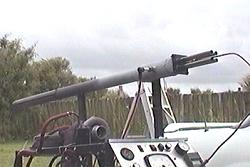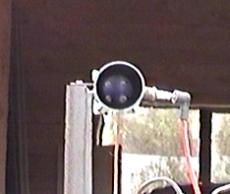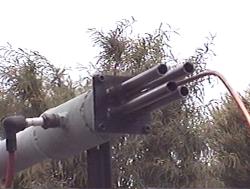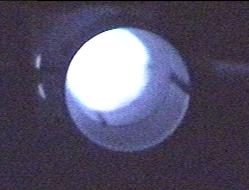Bringing the pulse jet engine into the 21st century
Last Updated: 4 February, 2001
|
Valveless Isn't Hard Although I have spent a lot of time, effort and money improving the basic design of the simple reed-valve system used by most pulse jet engines, I've always wondered why there appear to be so few examples of valveless pulsejets. The fundementals of valveless pulse jet operation are pretty simple to understand and very easy to implement so I decided to see if I could convert one of my existing (traditional reed-valved) engines to valveless operation. I decided to use my mid-sized prototype engine. It's an ugly engine -- this comes from being hacked and welded in a hundred different ways during the development of my ideas. It's also the engine I strapped to the gokart just for fun.
Here's a picture of what I ended up with -- a system of four pipes which produce a total intake area of about 35 percent of the tailpipe area and are welded straight onto a flat plate which bolts onto the front of the engine instead of the reed-valve block.
However, this is just a proof-of-concept experiment so I left them pointing straight forwards. First attempts to start the engine showed that the main tailpipe was not resonant with the intake system. Pops, bangs and a little flame -- but no sustained pulse-type combustion.
I cut 35 percent off the intake pipes and the engine almost ran -- but it was very eratic and very sensitive to the amount of fuel going in -- clearly it was still not quite on resonance. I cut another three quarters of an inch off two of the pipes only -- and the engine ran! This left the engine with two short intake pipes and two longer ones. I did this for a very good reason -- to broaden the operating band at which the intake system will resonate.
Now, when I say "almost" no moving parts -- I have retained the timed fuel injection system from my regular pulse jet engines which ensures that the fuel-flow is stopped during the combustion phase of the engine's operation. It's possible (probable?) that the engine would run without this little extra sophistication -- but it was easier to keep using it than to make up a new injector just for this test. Observations
Power Output In its standard form (with reed valves), this mid-sized engine produces a good solid 30 lbs of thrust and an incredible amount of noise. The valveless version is far quieter and I estimate that the combined thrust of the hot gasses coming out the front and those coming out the tailpipe would amount to no more than 3-4 lbs. Now I'm not suggesting that all valveless engines are this gutless -- I have to point out that this engine was never designed to operate as a valveless unit -- I simply wanted to prove that *any* pulse jet engine could run without valves. If I were to spend more time optimizing the combustion chamber, that intake system, and other aspects of the engine I'm sure I'd achieve much better performance.
Starting I have a feeling that the fuel-injection point is not optimal for valveless operation and should be moved back to well inside the combustion area rather than being on the plate where the intake pipes are welded. This suspicion was verified when I took the night-time video footage. Most of the combustion is taking place right at the front of the chamber. I think such a modification would improve the cold-starting and significantly improve the power output.
The Videos
|
|
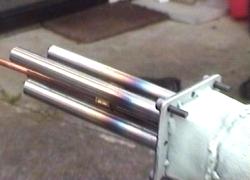
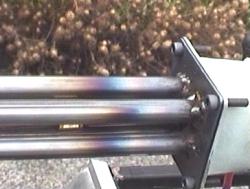 Yeah, okay, so it looks like a minigun -- and it's not particularly practical
in this configuration because the hot gasses which exit through these pipes
would oppose the thrust created out the tailpipe. If I were to continue
developing this design I'd turn those pipes through 180 degrees so they faced
back towards the rear fo the engine and contributed to the forward thrust.
Yeah, okay, so it looks like a minigun -- and it's not particularly practical
in this configuration because the hot gasses which exit through these pipes
would oppose the thrust created out the tailpipe. If I were to continue
developing this design I'd turn those pipes through 180 degrees so they faced
back towards the rear fo the engine and contributed to the forward thrust.
